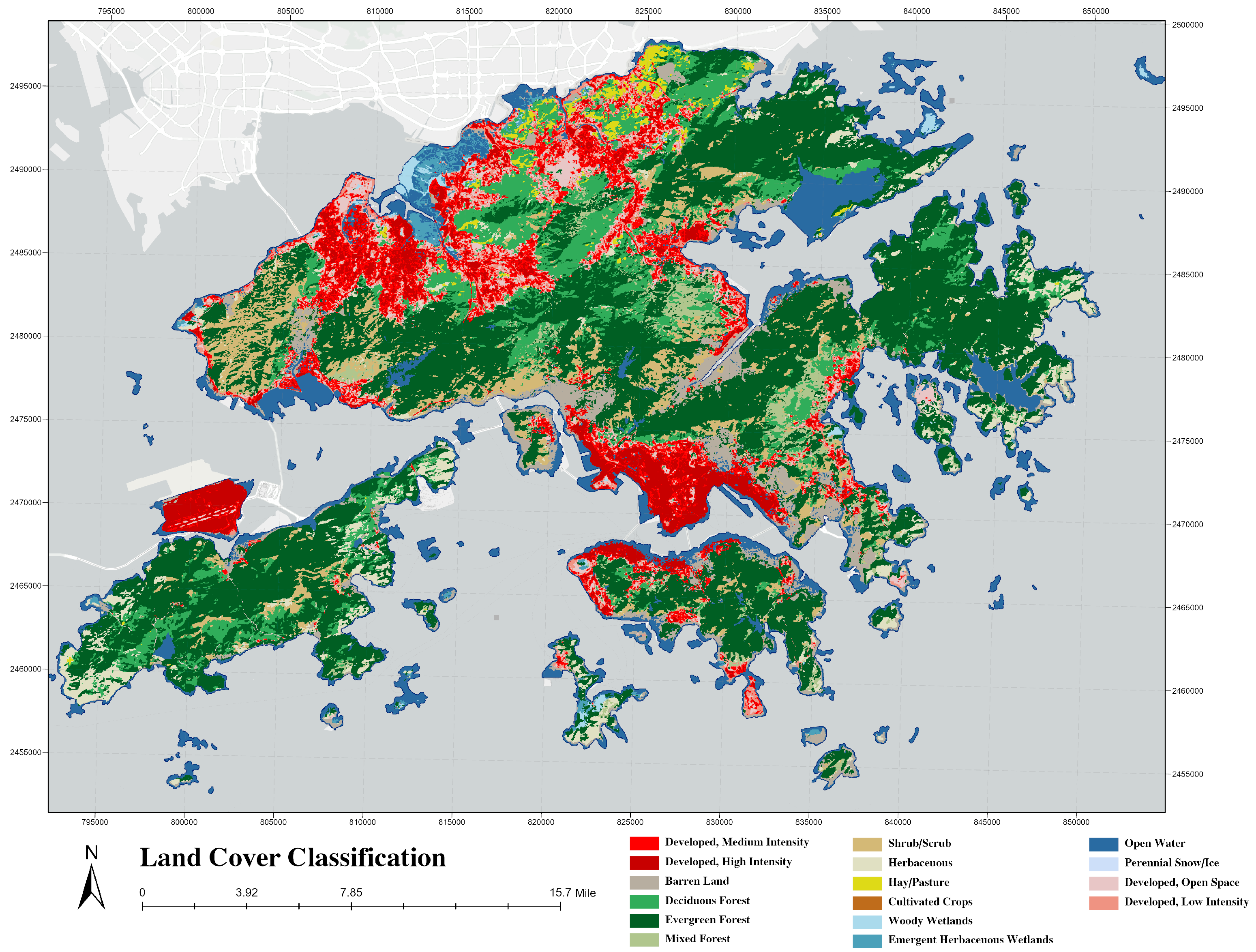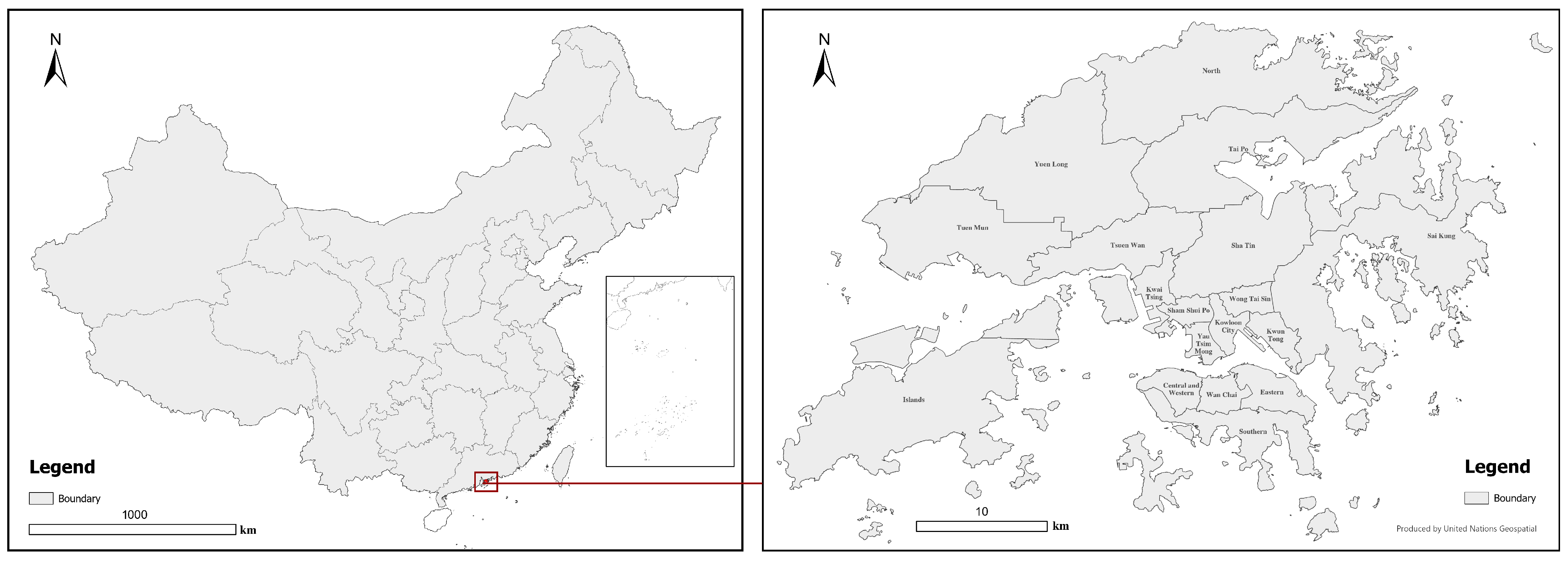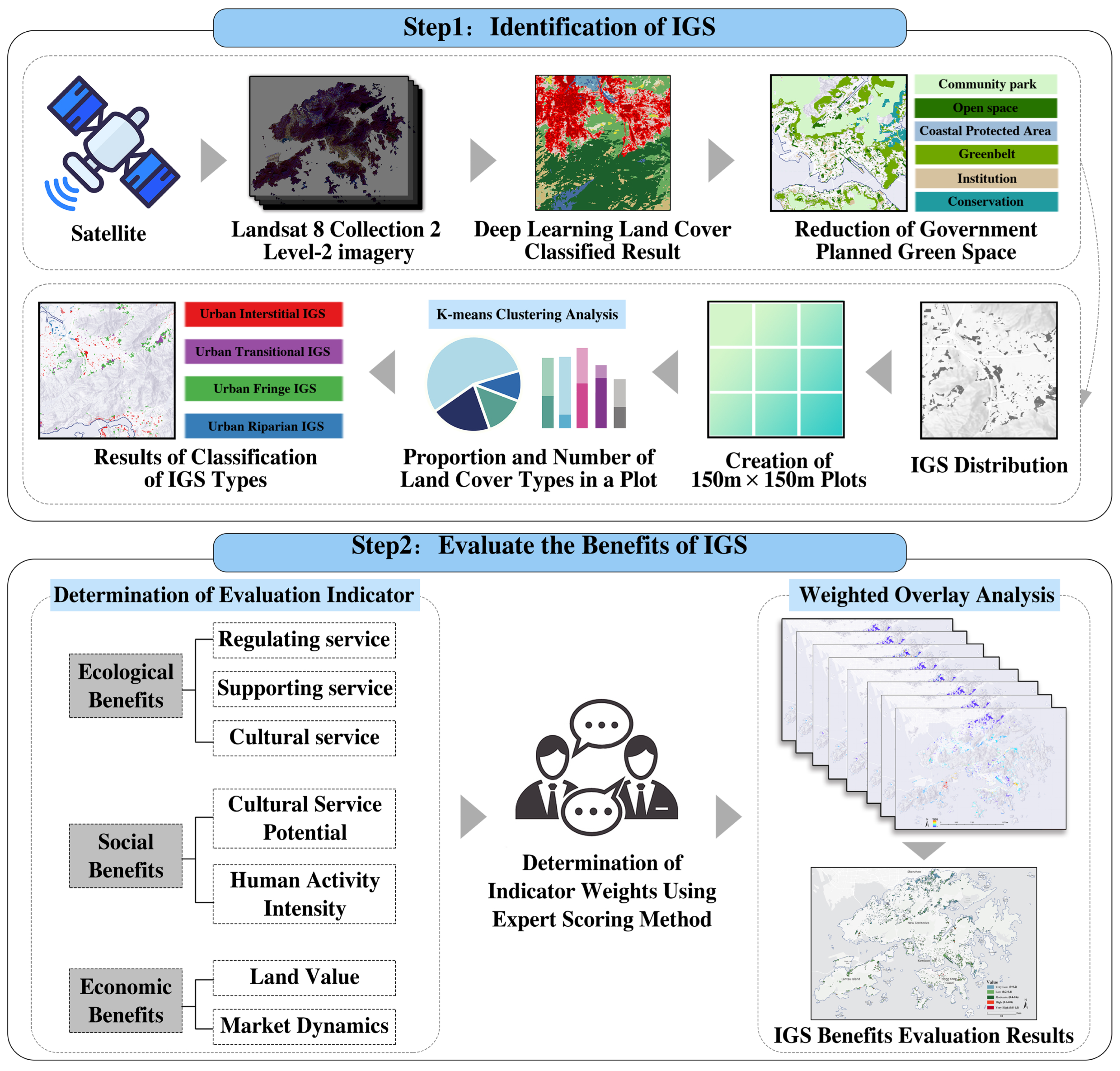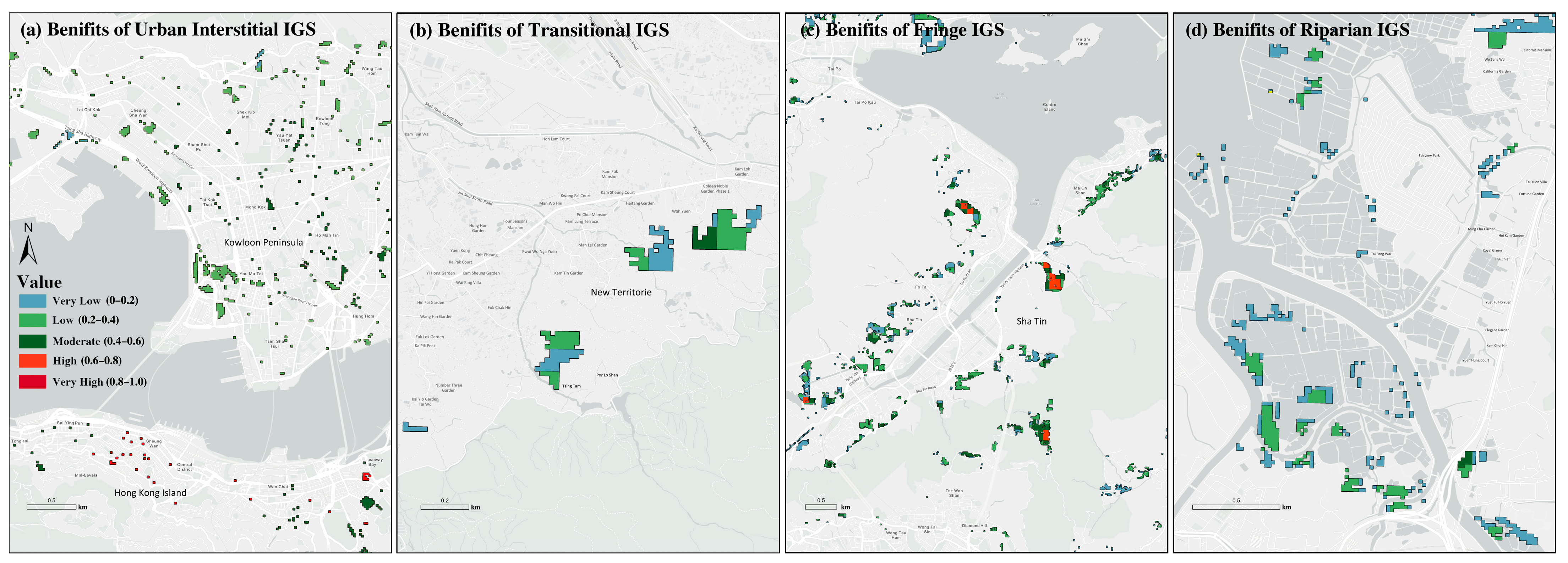Third Spaces to Represent Urban Greenery: A Study of Informal Green Spaces in a High-Density City Using Deep Learning and Geo-Weighted Analysis
Abstract
1. Introduction
- (1)
- How does one identify and classify Hong Kong’s IGSs?
- (2)
- What are the ecological, social, and economic benefits of different categories of Hong Kong’s IGSs?
- (3)
- How do IGSs influence the spatial equity of green space provision in Hong Kong?
2. Literature Review
3. Study Area and Research Method
3.1. Study Area
3.2. Research Method
3.3. Step 1: Identification of IGSs
3.4. Step 2: Evaluate the Benefits of IGSs
3.4.1. Ecological Benefits
3.4.2. Social Benefits
3.4.3. Economic Benefits
3.4.4. Weighted Overlay
4. Results
4.1. Distribution of IGS Typology
4.2. Benefits of IGS
4.2.1. Benefits of Interstitial IGSs
4.2.2. Benefits of Transitional IGSs
4.2.3. Benefits of Fringe IGSs
4.2.4. Benefits of Riparian IGSs
4.3. IGS as Supplements to GI in Low Green Space Areas
5. Discussion
5.1. IGSs as Critical Supplements to GI in High-Density Cities
5.2. Necessity of IGS Classification in Hong Kong’s High-Density Urban Context
5.3. Originality and Contributions
5.4. Limitations, Policy Implications, and Future Research Directions
6. Conclusions
Author Contributions
Funding
Data Availability Statement
Acknowledgments
Conflicts of Interest
Abbreviations
| IGSs | Informal green spaces |
| GI | Green infrastructure |
| UGSs | Urban green spaces |
| CNN | Convolutional neural network |
| WHO | World Health Organization |
Appendix A


References
- Lefebvre, H. The Production of Space; Nicholson-Smith, D., Translator; Blackwell: Oxford, UK, 1991. [Google Scholar]
- Soja, E. Thirdspace: Journeys to Los Angeles and Other Real-and-Imagined Places; Blackwell: Oxford, UK, 1996. [Google Scholar]
- Larsson, E.P.; Giritli Nygren, K. Cultivating Thirdspace: Community, Conflict and Place in Small-City Urban Gardens. Landsc. Urban Plan. 2024, 243, 104959. [Google Scholar] [CrossRef]
- Lee, A.C.K.; Maheswaran, R. The Health Benefits of Urban Green Spaces: A Review of the Evidence. J. Public Health 2011, 33, 212–222. [Google Scholar] [CrossRef]
- Maller, C.; Townsend, M.; Pryor, A.; Brown, P.; St Leger, L. Healthy Nature Healthy People: ‘Contact with Nature’ as an Upstream Health Promotion Intervention for Populations. Health Promot. Int. 2006, 21, 45–54. [Google Scholar] [CrossRef]
- Byrne, J.; Sipe, N.; Searle, G. Green Around the Gills? The Challenge of Density for Urban Greenspace Planning in SEQ. Aust. Plan. 2010, 47, 162–177. [Google Scholar] [CrossRef]
- Korkou, M.; Tarigan, A.K.M.; Hanslin, H.M. The Multifunctionality Concept in Urban Green Infrastructure Planning: A Systematic Literature Review. Urban For. Urban Green. 2023, 85, 127975. [Google Scholar] [CrossRef]
- Voskamp, I.; Van de Ven, F. Planning Support System for Climate Adaptation: Composing Effective Sets of Blue-Green Measures to Reduce Urban Vulnerability to Extreme Weather Events. Build. Environ. 2015, 83, 159–167. [Google Scholar] [CrossRef]
- Walmsley, A. Greenways: Multiplying and Diversifying in the 21st Century. Landsc. Urban Plan. 2006, 76, 252–290. [Google Scholar] [CrossRef]
- Kabisch, N.; van den Bosch, M.; Lafortezza, R. The Health Benefits of Nature-Based Solutions to Urbanization Challenges for Children and the Elderly—A Systematic Review. Environ. Res. 2017, 159, 362–373. [Google Scholar] [CrossRef]
- Kaplan, R.; Kaplan, S. The Experience of Nature: A Psychological Perspective; Cambridge University Press: Cambridge, UK, 1989. [Google Scholar]
- Park, J.; Kim, J. Economic Impacts of a Linear Urban Park on Local Businesses: The Case of Gyeongui Line Forest Park in Seoul. Landsc. Urban Plan. 2019, 181, 139–147. [Google Scholar] [CrossRef]
- Tian, Y.; Jim, C.Y.; Tao, Y.; Shi, T. Landscape Ecological Assessment of Green Space Fragmentation in Hong Kong. Urban For. Urban Green. 2011, 10, 79–86. [Google Scholar] [CrossRef]
- Mahmoudi Farahani, L.; Maller, C. Investigating the Benefits of ‘Leftover’ Places: Residents’ Use and Perceptions of an Informal Greenspace in Melbourne. Urban For. Urban Green. 2019, 41, 292–302. [Google Scholar] [CrossRef]
- Feng, S.; Kou, X.; Chang, J.; Hu, Z.; Li, C. Urban Informal Green Space: Concept, Type, Value and Renewal Design Model. South Archit. 2022, 3, 78–87. [Google Scholar]
- Kim, G.; Miller, P.; Nowak, D. The Value of Green Infrastructure on Vacant and Residential Land in Roanoke, Virginia. Sustainability 2016, 8, 296. [Google Scholar] [CrossRef]
- Penone, C.; Machon, N.; Julliard, R.; Le Viol, I. Do Railway Edges Provide Functional Connectivity for Plant Communities in an Urban Context? Biol. Conserv. 2012, 148, 126–133. [Google Scholar] [CrossRef]
- Colding, J.; Barthel, S. The Potential of ‘Urban Green Commons’ in the Resilience Building of Cities. Ecol. Econ. 2013, 86, 156–166. [Google Scholar] [CrossRef]
- Stanford, H.R.; Garrard, G.E.; Kirk, H.; Hurley, J. A Social-Ecological Framework for Identifying and Governing Informal Greenspaces in Cities. Landsc. Urban Plan. 2022, 221, 104378. [Google Scholar] [CrossRef]
- Rupprecht, C.; Byrne, J. Informal Urban Greenspace: A Typology and Trilingual Systematic Review of Its Role for Urban Residents and Trends in the Literature. Urban For. Urban Green. 2014, 13, 597–611. [Google Scholar] [CrossRef]
- Nassauer, J.I.; Raskin, J. Urban Vacancy and Land Use Legacies: A Frontier for Urban Ecological Research, Design, and Planning. Landsc. Urban Plan. 2014, 125, 245–253. [Google Scholar] [CrossRef]
- Németh, J.; Langhorst, J. Rethinking Urban Transformation: Temporary Uses for Vacant Land. Cities 2014, 40, 143–150. [Google Scholar] [CrossRef]
- Loukaitou-Sideris, A. Cracks in the City: Addressing the Constraints and Potentials of Urban Design. J. Urban Des. 1996, 1, 91–103. [Google Scholar] [CrossRef]
- Luo, S. The Cultural Ecosystem Services of Informal Green Spaces in Deprived Neighborhoods: An In-Depth Interview Study. AESOP Annu. Congr. Proc. 2024, 36. Available online: https://proceedings.aesop-planning.eu/index.php/aesopro/article/view/2271 (accessed on 1 September 2025).
- Sit, K.Y.; Chen, W.Y.; Ng, K.Y.; Koh, K.; Zhang, H. Unveiling Environmental Inequalities in a High-Density Asian City: City-Scaled Comparative Analysis of Green Space Coverage within 10-Minute Walk from Private, Public, and Rural Housing. Landsc. Urban Plan. 2025, 253, 105225. [Google Scholar] [CrossRef]
- Li, Z.; Chen, B.; Wu, S.; Su, M.; Chen, J.M.; Xu, B. Deep Learning for Urban Land Use Category Classification: A Review and Experimental Assessment. Remote Sens. Environ. 2024, 311, 114290. [Google Scholar] [CrossRef]
- Clark, A.; Phinn, S.; Scarth, P. Optimised U-Net for Land Use–Land Cover Classification Using Aerial Photography. PFG—J. Photogramm. Remote Sens. Geoinf. Sci. 2023, 91, 125–147. [Google Scholar] [CrossRef]
- Biernacka, M.; Kronenberg, J.; Łaszkiewicz, E.; Czembrowski, P.; Amini Parsa, V.; Sikorska, D. Beyond Urban Parks: Mapping Informal Green Spaces in an Urban–Peri-Urban Gradient. Land Use Policy 2023, 131, 106746. [Google Scholar] [CrossRef]
- Nielsen, T. The Return of the Excessive: Superfluous Landscapes. Space Cult. 2002, 5, 53–62. [Google Scholar] [CrossRef]
- Sikorska, D.; Łaszkiewicz, E.; Krauze, K.; Sikorski, P. The Role of Informal Green Spaces in Reducing Inequalities in Urban Green Space Availability to Children and Seniors. Environ. Sci. Policy 2020, 108, 144–154. [Google Scholar] [CrossRef]
- Cupers, K.; Miessen, M. Spaces of Uncertainty—Berlin Revisited: Potenziale Urbaner Nischen; Birkhäuser: Basel, Switzerland, 2018. [Google Scholar]
- Gandy, M. Unintentional Landscapes. Landsc. Res. 2016, 41, 433–440. [Google Scholar] [CrossRef]
- Mubi Brighenti, A. (Ed.) Urban Interstices: The Aesthetics and the Politics of the In-Between; Ashgate: Farnham, UK, 2013. [Google Scholar]
- Shaw, P. The Qualities of Informal Space: (Re)Appropriation within the Informal, Interstitial Spaces of the City. In Occupation: Negotiations with Constructed Space, Proceedings of the Conference, University of Brighton, Brighton, UK, 2–4 July 2009; University of Brighton: Brighton, UK, 2009. [Google Scholar]
- Tonnelat, S. ‘Out of Frame’: The (In)Visible Life of Urban Interstices—A Case Study in Charenton-le-Pont, Paris, France. Ethnography 2008, 9, 291–324. [Google Scholar] [CrossRef]
- Foster, J. Hiding in Plain View: Vacancy and Prospect in Paris’ Petite Ceinture. Cities 2014, 40, 124–132. [Google Scholar] [CrossRef]
- Gandy, M. Marginalia: Aesthetics, Ecology, and Urban Wastelands. Ann. Assoc. Am. Geogr. 2013, 103, 1301–1316. [Google Scholar] [CrossRef]
- Hu, X.; Zhuang, S. Large-Scale Spatial-Temporal Identification of Urban Vacant Land and Informal Green Spaces Using Semantic Segmentation. Remote Sens. 2024, 16, 216. [Google Scholar] [CrossRef]
- Phillips, D.; Lindquist, M. Just Weeds? Comparing Assessed and Perceived Biodiversity of Urban Spontaneous Vegetation in Informal Greenspaces in the Context of Two American Legacy Cities. Urban For. Urban Green. 2021, 62, 127151. [Google Scholar] [CrossRef]
- Threlfall, C.G.; Kendal, D. The Distinct Ecological and Social Roles That Wild Spaces Play in Urban Ecosystems. Urban For. Urban Green. 2018, 29, 348–356. [Google Scholar] [CrossRef]
- Mao, L.; Zheng, Z.; Meng, X.; Zhou, Y.; Zhao, P.; Yang, Z.; Long, Y. Large-Scale Automatic Identification of Urban Vacant Land Using Semantic Segmentation of High-Resolution Remote Sensing Images. Landsc. Urban Plan. 2022, 222, 104384. [Google Scholar] [CrossRef]
- Ma, S.; Long, Y. Mapping Potential Wilderness in China with Location-Based Services Data. Appl. Spat. Anal. Policy 2020, 13, 69–89. [Google Scholar] [CrossRef]
- Xu, S.; Ehlers, M. Automatic Detection of Urban Vacant Land: An Open-Source Approach for Sustainable Cities. Comput. Environ. Urban Syst. 2022, 91, 101729. [Google Scholar] [CrossRef]
- Feltynowski, M.; Kronenberg, J.; Bergier, T.; Kabisch, N.; Łaszkiewicz, E.; Strohbach, M.W. Challenges of Urban Green Space Management in the Face of Using Inadequate Data. Urban For. Urban Green. 2018, 31, 56–66. [Google Scholar] [CrossRef]
- Fainstein, S.S. The Just City. Int. J. Urban Sci. 2014, 18, 1–18. [Google Scholar] [CrossRef]
- Dai, D. Racial/Ethnic and Socioeconomic Disparities in Urban Green Space Accessibility: Where to Intervene? Landsc. Urban Plan. 2011, 102, 234–244. [Google Scholar] [CrossRef]
- Knaus, M.; Haase, D. Green Roof Effects on Daytime Heat in a Prefabricated Residential Neighbourhood in Berlin, Germany. Urban For. Urban Green. 2020, 53, 126738. [Google Scholar] [CrossRef]
- Sikorski, P.; Gawryszewska, B.; Sikorska, D.; Chormański, J.; Schwerk, A.; Jojczyk, A.; Ciężkowski, W.; Archiciński, P.; Łepkowski, M.; Dymitryszyn, I.; et al. The Value of Doing Nothing—How Informal Green Spaces Can Provide Comparable Ecosystem Services to Cultivated Urban Parks. Ecosyst. Serv. 2021, 50, 101339. [Google Scholar] [CrossRef]
- Ke, X.; Huang, D.; Zhou, T.; Men, H. Contribution of Non-Park Green Space to the Equity of Urban Green Space Accessibility. Ecol. Indic. 2023, 146, 109855. [Google Scholar] [CrossRef]
- Sanches, P.M.; Mesquita Pellegrino, P.R. Greening Potential of Derelict and Vacant Lands in Urban Areas. Urban For. Urban Green. 2016, 19, 128–139. [Google Scholar] [CrossRef]
- Aleksejeva, J.; Voulgaris, G.; Gasparatos, A. Assessing the Potential of Strategic Green Roof Implementation for Green Infrastructure: Insights from Sumida Ward, Tokyo. Urban For. Urban Green. 2022, 74, 127632. [Google Scholar] [CrossRef]
- Lu, M.; Jin, M.; Yan, Z. Evaluation of the Potential for Renewing Urban Vacant Land into Green Infrastructure. Landsc. Archit. 2024, 31, 81–88. [Google Scholar] [CrossRef]
- Census and Statistics Department. Table E489: Land Area, Mid-Year Population and Population Density by District Council District. 2023. Available online: https://www.censtatd.gov.hk/en/web_table.html?id=110-02001 (accessed on 1 September 2025).
- Jain, A.K.; Murty, M.N.; Flynn, P.J. Data Clustering: A Review. ACM Comput. Surv. 1999, 31, 264–323. [Google Scholar] [CrossRef]
- Gui, R.; Song, W.; Lv, J.; Lu, Y.; Liu, H.; Feng, T.; Linghu, S. Digital Elevation Model-Driven River Channel Boundary Monitoring Using the Natural Breaks (Jenks) Method. Remote Sens. 2025, 17, 1092. [Google Scholar] [CrossRef]
- Longley, P.A.; Goodchild, M.F.; Maguire, D.J.; Rhind, D.W. Spatial Analysis Online: A Guide to Geospatial Analysis in GIS. Available online: https://www.spatialanalysisonline.com/HTML/index.html (accessed on 1 September 2025).
- Solórzano, J.V.; Mas, J.F.; Gao, Y.; Gallardo-Cruz, J.A. Land Use/Land Cover Classification with U-Net: Advantages of Combining Sentinel-1 and Sentinel-2 Imagery. Remote Sens. 2021, 13, 3600. [Google Scholar] [CrossRef]
- Esri. ArcGIS Online Item. Available online: https://www.arcgis.com/home/item.html?id=e732ee81a9c14c238a14df554a8e3225 (accessed on 31 August 2025).
- Talha, M.; Bhatti, F.A.; Ghuffar, S.; Zafar, H. ADU-Net: Semantic Segmentation of Satellite Imagery for Land Cover Classification. Adv. Space Res. 2023, 72, 1780–1788. [Google Scholar] [CrossRef]
- Xie, X.; Ye, L.; Kang, X.; Yan, L.; Zeng, L. Land Use Classification Using Improved U-Net in Remote Sensing Images of Urban and Rural Planning Monitoring. Sci. Program. 2022, 2022, 3125414. [Google Scholar] [CrossRef]
- Preston, P.D.; Dunk, R.M.; Smith, G.R.; Cavan, G. Not All Brownfields Are Equal: A Typological Assessment Reveals Hidden Green Space in the City. Landsc. Urban Plan. 2023, 229, 104590. [Google Scholar] [CrossRef]
- Aram, F.; García, E.H.; Solgi, E.; Mansournia, S. Urban Green Space Cooling Effect in Cities. Heliyon 2019, 5, e01339. [Google Scholar] [CrossRef]
- Vickers, D.; Rees, P. Creating the UK National Statistics 2001 Output Area Classification. J. R. Stat. Soc. Ser. A (Stat. Soc.) 2007, 170, 379–403. [Google Scholar] [CrossRef]
- Zeng, L.; Li, R.Y.M.; Du, H. Modeling the Ecological Network in Mountainous Resource-Based Cities: Morphological Spatial Pattern Analysis Approach. Buildings 2025, 15, 1388. [Google Scholar] [CrossRef]
- Rousseeuw, P.J. Silhouettes: A Graphical Aid to the Interpretation and Validation of Cluster Analysis. J. Comput. Appl. Math. 1987, 20, 53–65. [Google Scholar] [CrossRef]
- Galalizadeh, S.; Morrison-Saunders, A.; Horwitz, P.; Silberstein, R.; Blake, D. The Cooling Impact of Urban Greening: A Systematic Review of Methodologies and Data Sources. Urban For. Urban Green. 2024, 95, 128157. [Google Scholar] [CrossRef]
- Kelleher, C.; Golden, H.E.; Burkholder, S.; Shuster, W. Urban Vacant Lands Impart Hydrological Benefits across City Landscapes. Nat. Commun. 2020, 11, 1563. [Google Scholar] [CrossRef] [PubMed]
- Lee, J.; Kweon, B.-S.; Ellis, C.D.; Lee, S.-W. Assessing the Social Value of Ecosystem Services for Resilient Riparian Greenway Planning and Management in an Urban Community. Int. J. Environ. Res. Public Health 2020, 17, 3261. [Google Scholar] [CrossRef]
- Dong, J.; Guo, R.-N.; Guo, F. Potential Assessment and Renewal Strategy for Regenerating Urban Abandoned Railways: The Case Study of the Dalian Locomotive Factory Railway Line. J. Nat. Resour. 2023, 38, 2672–2686. [Google Scholar] [CrossRef]
- Feng, S.; Hou, W.; Chang, J. Changing Coal Mining Brownfields into Green Infrastructure Based on Ecological Potential Assessment in Xuzhou, Eastern China. Sustainability 2019, 11, 2252. [Google Scholar] [CrossRef]
- Wen, H.Z.; Goodman, A.C. Relationship between Urban Land Price and Housing Price: Evidence from 21 Provincial Capitals in China. Habitat Int. 2013, 40, 9–17. [Google Scholar] [CrossRef]
- UN-Habitat. Developing Public Space and Land Values in Cities and Neighbourhoods; United Nations Human Settlements Programme: Nairobi, Kenya, 2015; Available online: https://unhabitat.org/sites/default/files/download-manager-files/Discussion%20Paper%20-%20Developing%20Public%20Space%20and%20Land%20Values%20in%20Cities%20and%20Neighbourhoods.pdf (accessed on 1 September 2025).
- Tang, B. Is the Distribution of Public Open Space in Hong Kong Equitable, Why Not? Landsc. Urban Plan. 2017, 161, 80–89. [Google Scholar] [CrossRef]
- Moroni, S. The Just City. Three Background Issues: Institutional Justice and Spatial Justice, Social Justice and Distributive Justice, Concept of Justice and Conceptions of Justice. Plan. Theory 2020, 19, 251–267. [Google Scholar] [CrossRef]
- Kim, M.; Rupprecht, C.D.D.; Furuya, K. Residents’ Perception of Informal Green Space—A Case Study of Ichikawa City, Japan. Land 2018, 7, 102. [Google Scholar] [CrossRef]
- Hong Kong Planning Department. Green and Blue Space Conceptual Framework. 2016. Available online: https://www.pland.gov.hk/file/planning_studies/comp_s/hk2030plus/document/Green%20and%20Blue%20Space%20Conceptual%20Framework_Eng.pdf (accessed on 1 August 2025).
- Krull, W.; Berry, P.; Bauduceau, N.; Cecchi, C.; Elmqvist, T.; Fernandez, M.; Hartig, T.; Mayerhofer, E.; Naumann, S.; Noring, L.; et al. Towards an EU Research and Innovation Policy Agenda for Nature-Based Solutions & Re-Naturing Cities; Publications Office of the European Union: Luxembourg, 2015; Available online: https://iris.uniroma1.it/handle/11573/777994 (accessed on 1 September 2025).






| Type | Source |
|---|---|
| Land utilization in Hong Kong | Planning Department (https://www.pland.gov.hk/ accessed on 10 September 2024) |
| Landsat 8 remote sensing imagery | NASA (https://www.nasa.gov/ accessed on 15 September 2024) |
| Public transport | Hong Kong CSDI Portal (https://portal.csdi.gov.hk accessed on 20 September 2024) |
| Educational infrastructure | DATA.GOV.HK (https://DATA.GOV.HK/ accessed on 20 September 2024) |
| Commercial infrastructure | DATA.GOV.HK (https://DATA.GOV.HK/ accessed on 20 September 2024) |
| Population density | Hong Kong CSDI Portal (https://portal.csdi.gov.hk accessed on 20 September 2024) |
| Property valuation list | DATA.GOV.HK (https://DATA.GOV.HK/ accessed on 21 September 2024) |
| Average income | Hong Kong CSDI Portal (https://portal.csdi.gov.hk accessed on 21 September 2024) |
| Indicator Layer | Computational Formula | Explanations |
|---|---|---|
| Gas Regulation | indicates different categories of ecosystem service values; represents the area of land use type ; and refers to the ecosystem service value coefficient per unit area of land use type . | |
| Climate Regulation | ||
| Hydrological Regulation | ||
| Soil Conservation | ||
| Nutrient Cycling Maintenance | ||
| Biodiversity | ||
| Landscape Esthetics | ||
| Transit Accessibility | The density of public transport stations within the evaluation unit, where is the total number of stations in the neighborhood, and is the area of the evaluation unit. | |
| Population Density | W denotes the population, and represents the area of the evaluation unit. | |
| Commercial Infrastructure | denotes the kernel density estimate at location x; is the total number of points; is the search radius; represents the distance between location and sample point ; is the kernel function. | |
| Educational Infrastructure | ||
| Housing Value | ||
| Average Income | denotes the per capita income of the area where the sampling unit is located. |
| Objective Layer | Criteria Layer | Indicator Layer | Weight |
|---|---|---|---|
| Ecological Benefits [52] | Regulating service | Gas Regulation | 0.1368 |
| Climate Regulation | 0.1368 | ||
| Hydrological Regulation | 0.0177 | ||
| Supporting service | Soil Conservation | 0.0344 | |
| Nutrient Cycling Maintenance | 0.0196 | ||
| Biodiversity | 0.0381 | ||
| Cultural service | Landscape Esthetics | 0.0486 | |
| Social Benefits [50,69,70] | Cultural Service Potential | Transit Accessibility | 0.1382 |
| Human Activity Intensity | Population Density | 0.0809 | |
| Commercial Infrastructure | 0.0731 | ||
| Educational Infrastructure | 0.0369 | ||
| Economic Benefits [69,71] | Land Value | Housing Value | 0.1486 |
| Market Dynamics | Average Income | 0.0901 |
| Benefits Category | Urban Interstitial IGSs | Transitional IGSs | Fringe IGSs | Riparian IGSs | |
|---|---|---|---|---|---|
| Average Benefits | Gas Regulation | 0.0229 | 0.0655 | 0.0916 | 0.0582 |
| Climate Regulation | 0.0201 | 0.0663 | 0.0880 | 0.051 | |
| Hydrological Regulation | 0.0211 | 0.0662 | 0.0540 | 0.0713 | |
| Soil Conservation | 0.0227 | 0.0655 | 0.0916 | 0.0581 | |
| Nutrient Cycling Maintenance | 0.0218 | 0.0654 | 0.0917 | 0.0584 | |
| Biodiversity | 0.0289 | 0.0660 | 0.0886 | 0.0826 | |
| Landscape Esthetics | 0.0243 | 0.0662 | 0.0678 | 0.0758 | |
| Transit Accessibility | 0.2235 | 0.0505 | 0.0985 | 0.0337 | |
| Population Density | 0.0860 | 0.0106 | 0.0306 | 0.0280 | |
| Commercial Infrastructure | 0.0316 | 0.0078 | 0.0160 | 0.0035 | |
| Educational Infrastructure | 0.1749 | 0.0361 | 0.0750 | 0.0354 | |
| Housing Value | 0.2390 | 0.1847 | 0.2130 | 0.1543 | |
| Average Income | 0.3417 | 0.3459 | 0.3203 | 0.3284 | |
| Unweighted Overlay of Benefits | Ecological Benefits | 0.1618 | 0.4611 | 0.5733 | 0.4554 |
| Social Benefits | 0.5160 | 0.105 | 0.2201 | 0.1006 | |
| Economic Benefits | 0.5807 | 0.5306 | 0.5333 | 0.4827 | |
| Weighted Overlay of Benefits | Aggregate benefits | 0.1227 | 0.0968 | 0.1177 | 0.0872 |
| District | GI/Person | IGS/Person | Combined GI and IGS/Person |
|---|---|---|---|
| Kowloon City | 8.41 | 4.46 | 12.87 |
| Kwun Tong | 5.69 | 2.50 | 8.19 |
| Sham Shui Po | 7.61 | 0.71 | 8.32 |
| Wong Tai Sin | 8.48 | 0.84 | 9.32 |
| Yau Tsim Mong | 5.49 | 0.92 | 6.41 |
Disclaimer/Publisher’s Note: The statements, opinions and data contained in all publications are solely those of the individual author(s) and contributor(s) and not of MDPI and/or the editor(s). MDPI and/or the editor(s) disclaim responsibility for any injury to people or property resulting from any ideas, methods, instructions or products referred to in the content. |
© 2025 by the authors. Published by MDPI on behalf of the International Society for Photogrammetry and Remote Sensing. Licensee MDPI, Basel, Switzerland. This article is an open access article distributed under the terms and conditions of the Creative Commons Attribution (CC BY) license (https://creativecommons.org/licenses/by/4.0/).
Share and Cite
Hou, X.; Tian, Y.; Chen, M. Third Spaces to Represent Urban Greenery: A Study of Informal Green Spaces in a High-Density City Using Deep Learning and Geo-Weighted Analysis. ISPRS Int. J. Geo-Inf. 2025, 14, 368. https://doi.org/10.3390/ijgi14100368
Hou X, Tian Y, Chen M. Third Spaces to Represent Urban Greenery: A Study of Informal Green Spaces in a High-Density City Using Deep Learning and Geo-Weighted Analysis. ISPRS International Journal of Geo-Information. 2025; 14(10):368. https://doi.org/10.3390/ijgi14100368
Chicago/Turabian StyleHou, Xiaoya, Yu Tian, and Mingze Chen. 2025. "Third Spaces to Represent Urban Greenery: A Study of Informal Green Spaces in a High-Density City Using Deep Learning and Geo-Weighted Analysis" ISPRS International Journal of Geo-Information 14, no. 10: 368. https://doi.org/10.3390/ijgi14100368
APA StyleHou, X., Tian, Y., & Chen, M. (2025). Third Spaces to Represent Urban Greenery: A Study of Informal Green Spaces in a High-Density City Using Deep Learning and Geo-Weighted Analysis. ISPRS International Journal of Geo-Information, 14(10), 368. https://doi.org/10.3390/ijgi14100368








